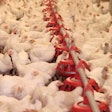Evidence suggests the highly pathogenic avian influenza (HPAI) virus strain, H5N1, performs best in low temperature conditions. FAO recently delivered a stark warning about steep rises in avian flu outbreaks as Northern Hemisphere countries entered winter 2007/8.
David Nabarro, the United Nations’ co-ordinator for avian flu and influenza claimed, “The northern winter seems to be a time when the risk of the disease [H5N1 HPAI] in poultry increases, and it's partly to do with the fact that this virus quite likes cold weather.”
In spite of cumulative evidence and warnings, poultry in Scandinavian countries Norway, Sweden, Denmark, Finland and Iceland have been virtually free of avian flu, despite serious multiple outbreaks to the east (Russia), to the south-east (Poland, Czech Republic and Hungary) and due south in Germany and United Kingdom and Germany.
The reason is quite simply that Scandinavians do not take risks with H5N1. The virus is currently ripping the heart out of Poland’s big export-orientated poultry industry and has just reappeared in southern Russia (Rostov) and eastern Germany (Brandenburg) after summer outbreaks. The UK has just lifted H5N1 restrictions in time for Christmas after a serious outbreak in its East Anglia prestige poultry industry.
None of these outbreaks is close to Scandinavia but the poultry industries there are concerned with good long term records on animal health. Reports by Earthtimes in mid-December 2007 said both Sweden and Denmark were giving instructions to poultry owners about locking up their birds to avoid contact with infected wild birds.
Swedes raise AI risk to moderate
According to these reports, Swedish authorities raised the alert level for southern Sweden following H5N1 outbreaks in Germany and Poland during December 2007. Sweden’s Board of Agriculture said there were no reports of increased deaths among poultry or wildfowl in Sweden, but recent outbreaks in poultry in northern Poland near the Baltic Sea were uncomfortably close. Consequently ‘protection level’ for southern Sweden (south of the main Dalälven River) was raised from level 1 to level 2, meaning the authorities considered there is a moderate risk. Poultry owners were ordered to keep their chickens indoors, while all exhibitions and competitions involving any birds whatsoever were banned. Ducks, geese, and other farmed game birds and hobby flocks were allowed to remain outdoors but only if enclosed.
Danes bring poultry inside
These precautionary moves in Sweden came just one day after equivalent measures were announced in Denmark. The Danish Veterinary and Food Administration introduced measures after the recurrence of H5N1 in poultry in neighbouring Germany. Authorities told poultry owners to keep birds indoors or under protective nets after this German outbreak, which was reported at the same time as more the more widespread and serious outbreaks in Poland.
Denmark is one of many European countries to have recorded H5N1 in wild birds, and there was a single outbreak in a small backyard poultry flock in spring 2006. Annual poultrymeat production is over 200,000 tonnes with at least half exported, meaning Danish poultry production is clearly valuable and economically at risk should H5N1 get into commercial flocks.
Iceland prepared
Way out in the North Atlantic, Iceland has much less to worry about from HPAI. However, the island is an important site in the network of stopover and breeding sites for Northern Hemisphere wild waterfowl. Clearly concerned and wishing to be prepared for H5N1, the Agricultural Authority carried out an avian flu exercise in 2007 by exterminating healthy birds at a poultry farm at Miklaholtshellir near Selfoss, south Iceland.
Forty participants including veterinarians met at the Agricultural Authority in Selfloss and then drove to the farm, culled 2500 healthy birds by asphyxiation with carbon dioxide gas, and buried the carcasses. Afterwards representatives from the Work Supervision Authority, the Disease Prevention Authority and the Institute for Experimental Pathology of the University of Iceland reviewed the methods and equipment used.
Senior Veterinarian Halldór Rúnólfsson told Fréttabladid and Iceland Review, “These practices were organised to see how this worked in reality and find out whether there are any flaws in execution of the plan. These [layer] birds were at the end of their productive lives and were due to be killed anyway so we used the opportunity and turned it into an exercise.”
Such exercises may be seen to detract from the industry’s image. It evoked strong criticism from Sigrídur Ásgeirsdoóttir, director of the Animal Protection Union of Iceland. She took issue with the use of carbon dioxide, which suffocates birds rather than the quicker kill provided by acutely toxic gases.



.jpg?auto=format%2Ccompress&fit=crop&h=167&q=70&w=250)













